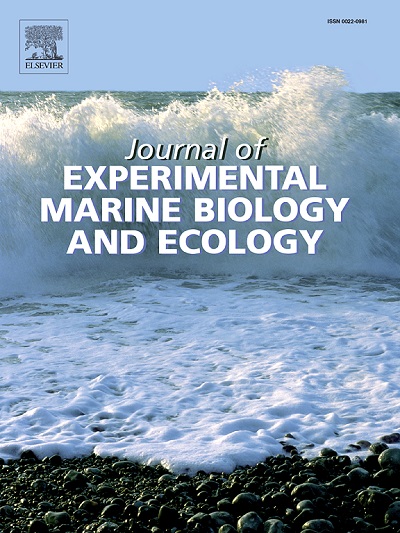Turning the tide: Rhythmic aggregation behaviour in Anurida maritima (Collembola) is entrained by inundation
IF 1.8
3区 生物学
Q3 ECOLOGY
Journal of Experimental Marine Biology and Ecology
Pub Date : 2024-10-15
DOI:10.1016/j.jembe.2024.152062
引用次数: 0
Abstract
Numerous foreshore species evolved the ability to predict tidal change and adjust behaviour and metabolism accordingly. The intertidal collembolan Anurida maritima (Guérin-Méneville, 1836) shows endogenously controlled rhythmic changes in behaviour that anticipate the tides. Animals forage during low tide and hide in large aggregations in the substrate during high tide. Here, artificial tidal environments and time-lapse photography were used to investigate if this behaviour is responsive to key environmental cues. It is shown that the precise rhythmicity of aggregation behaviour is dependent on periodic inundations. In the absence of such inundations, rhythmic aggregation patterns dissipate and are no longer accurate after 14 days. Slowly shifting the artificial tides, showed that rhythmic aggregation behaviour in A. maritima is responsive and adjusts to a newly-imposed tidal regimen. This suggests that the species has the ability to synchronise to newly encountered tidal conditions under natural conditions. The findings provide a robust foundation for advancing detailed chronobiological research on A. maritima as a model organism to gain a deeper understanding of biological time-keeping.
扭转潮流:淹没对海洋栉水母(Anurida maritima)有节律的聚集行为的影响
许多前滩物种进化出了预测潮汐变化并相应调整行为和新陈代谢的能力。潮间带蛞蝓 Anurida maritima(Guérin-Méneville,1836 年)表现出预测潮汐的内生控制行为节律变化。动物在退潮时觅食,在涨潮时躲藏在底层的大型聚集体中。在这里,我们利用人工潮汐环境和延时摄影来研究这种行为是否对关键的环境线索做出反应。研究表明,聚集行为的精确节律取决于周期性淹没。如果没有这种淹没,有节奏的聚集模式就会消失,14 天后就不再准确。人工潮汐的缓慢变化表明,A. maritima 的节律性聚集行为对新实施的潮汐制度有反应和适应能力。这表明,在自然条件下,该物种有能力与新遇到的潮汐条件同步。这些发现为推进将海牛作为模式生物进行详细的时间生物学研究奠定了坚实的基础,从而加深了对生物计时的理解。
本文章由计算机程序翻译,如有差异,请以英文原文为准。
求助全文
约1分钟内获得全文
求助全文
来源期刊
CiteScore
4.30
自引率
0.00%
发文量
98
审稿时长
14 weeks
期刊介绍:
The Journal of Experimental Marine Biology and Ecology provides a forum for experimental ecological research on marine organisms in relation to their environment. Topic areas include studies that focus on biochemistry, physiology, behavior, genetics, and ecological theory. The main emphasis of the Journal lies in hypothesis driven experimental work, both from the laboratory and the field. Natural experiments or descriptive studies that elucidate fundamental ecological processes are welcome. Submissions should have a broad ecological framework beyond the specific study organism or geographic region.
Short communications that highlight emerging issues and exciting discoveries within five printed pages will receive a rapid turnaround. Papers describing important new analytical, computational, experimental and theoretical techniques and methods are encouraged and will be highlighted as Methodological Advances. We welcome proposals for Review Papers synthesizing a specific field within marine ecology. Finally, the journal aims to publish Special Issues at regular intervals synthesizing a particular field of marine science. All printed papers undergo a peer review process before being accepted and will receive a first decision within three months.

 求助内容:
求助内容: 应助结果提醒方式:
应助结果提醒方式:


